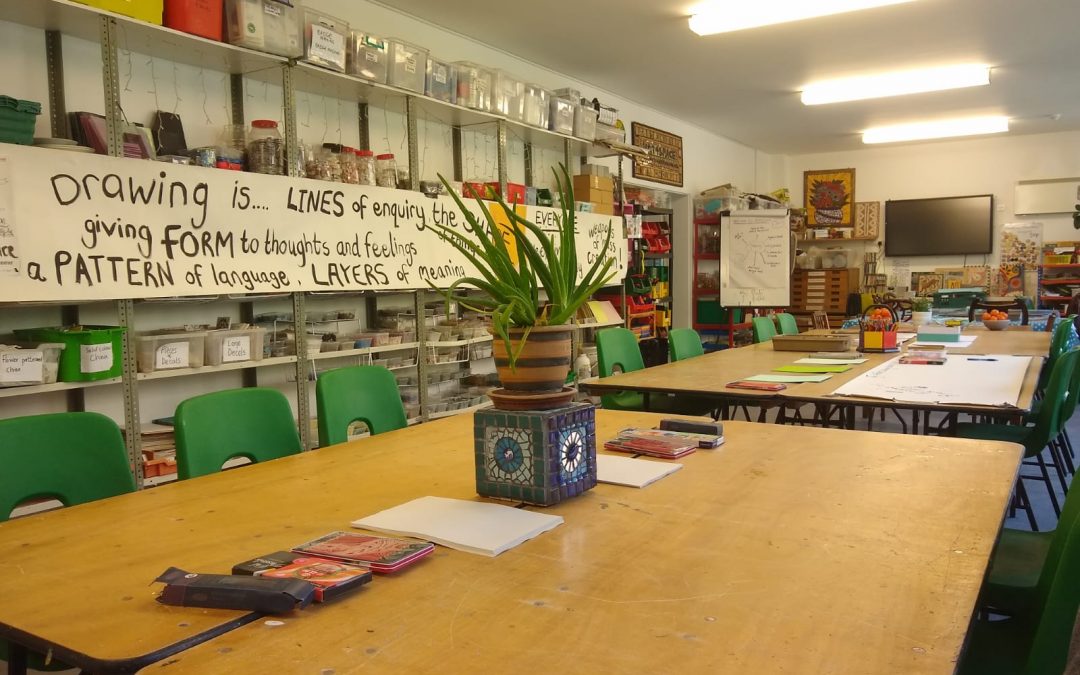Alice had her placement from her masters at Goldsmiths University with Art4Space until December 2022, and has written her reflections from working with us.
For the past couple of months, I have been on placement at Art4Space from Goldsmith’s University to inform my knowledge of what best makes a ‘Community Arts Practice’ and to reflect on how, as facilitators, community arts workers can bridge the gap between a participatory style of working and a community-based approach. I have been surprised and inspired by the participant-focused approach that is at the core of Art4Space and how this contributes to an anti-oppressive manner and a successful, uplifting, community work ethic.
Moving away from a mode of ‘teaching’ (which generally looks like a leader/teacher who guides participants and usually has a desired aesthetic outcome) where it is implied that there is already something existent wherein one can join in, community arts is focused on participant-centered practice and goals, drawing ideas from the community and creating something new together (and, in so doing, creating a sense of community and belonging). Although it might not feel like it at the time of creating, both participatory and community art results in the political; Francois Matarasso describes participatory art as ‘a form of cultural democratisation (or giving people access to the arts)’ and community arts as ‘aspiring to cultural democracy’ (Matarasso, ‘Understanding participatory and community art (Part 1), ). I felt that Art4Space brings both of these political agendas to their community through the variety of classes, Open Studio days and courses that are on offer and for whom they make an inclusive space.
One of the advantages of focusing on a community arts-based approach is, in this sense, how it lends itself to an anti-oppressive way of working. One of the remarkable strengths of Art4Space is how the staff are able to create a welcoming space, facilitate participant-let and participant-controlled services and reduced staff involvement unless needed and when helpful. This approach, which is so well embedded in the staff’s practice, leads to obvious signs of an evolving sense of self, resilience and self-esteem. As I was brand new to mosaic, this allowed participants to guide and advise me; a clear example of how sharing ideas between different groups of people leads to this central idea of cultural change and potential shifts in power dynamics.
I found that I was often observing the constantly changing function of the space dependent on the needs of the people in the studio. I was asking myself: ‘Is this a community centre or an art studio?’ and- ‘what are the fundamental differences between the two?’. This shift between ‘space functionality’ and ‘need’ seemed to blend or separate depending on who I was working alongside; some participants were really driven by the need for studio space, materials and expert guidance from staff whereas others felt that the importance of being around other artists, and in an inclusive supporting space, was more fundamental to them and outweighed the practice itself. Art4Space also demonstrated many therapeutic outcomes from their courses which is dependent on both the environment they have cultivated as well as the restorative and healing practice of creating art. I believe, however, that the hybridity of Art4Space, and indeed it’s staff, is what is central to community arts practices. Surely, to meet the needs of a community through an inclusive creation of art is addressing the political issues inherent in communities (access to art, political voice, agency, opportunity for self-expression, isolation)?
I would have loved to have observed and worked with Art4Space for longer to see the other ways in which the space is used, needed and transformed. I understand the challenges faced with the current cost of living and arts funding cutbacks can have when continuing to embed the ethics of community arts, anti-oppression and community uplifting in a time when almost everyone, it seems, is affected. I am moved by the extent to which Art4Space champions the participants who walk through their doors despite these difficulties. I really hope to stay in touch with the team I worked with there, and look forward to seeing their continuation and cultivation of community arts.

